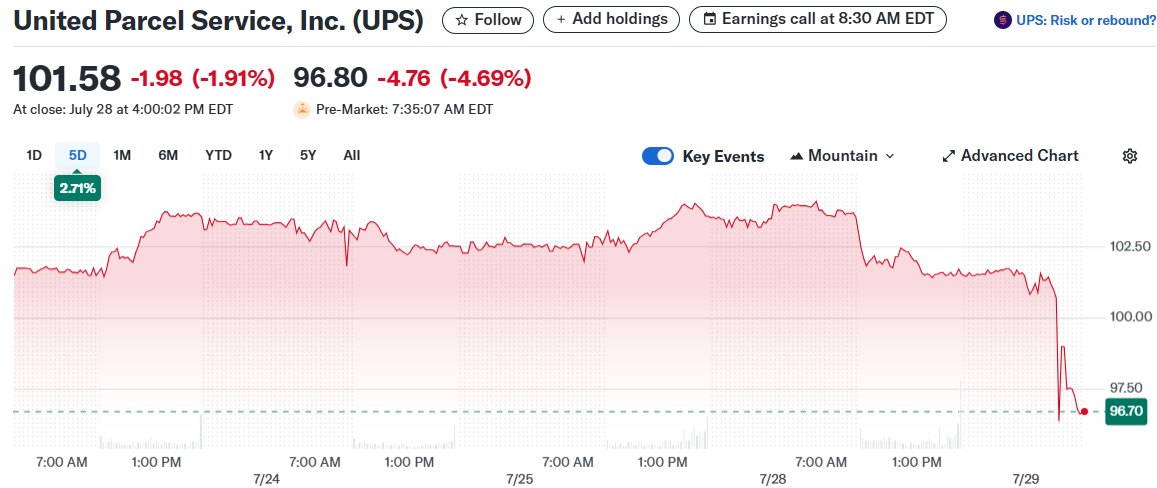TLDR
- UPS second-quarter earnings fell to $1.55 per share from $1.79 last year, missing Wall Street estimates of $1.56
- Revenue dropped to $21.2 billion from $21.8 billion in the same quarter last year due to weak demand
- New tariffs on Chinese shipments under $800 are hurting business from e-commerce platforms like Temu and Shein
- Company did not update full-year guidance for second consecutive quarter, citing economic uncertainty
- Stock dropped nearly 5% in premarket trading following the earnings announcement
United Parcel Service reported disappointing second-quarter results that sent shares tumbling in early trading Tuesday. The delivery giant posted earnings of $1.55 per share, falling short of Wall Street’s $1.56 estimate.

Revenue declined to $21.2 billion from $21.8 billion in the same quarter last year. The drop reflects ongoing challenges facing the logistics industry as demand remains weak across multiple segments.
The company’s struggles stem partly from new tariffs on low-value Chinese shipments. The White House began collecting duties on packages under $800 from China in May, ending a previous exemption.
These tariffs were initially set at 120% but were reduced to 54% as part of a trade agreement. Even at the lower rate, consumer demand has taken a hit as customers pull back on discretionary online purchases.
Tariff Impact Hurts Profitable Routes
The tariff changes particularly affect UPS’s most profitable China-to-U.S. trade lanes. Bargain e-commerce sellers like Temu and Shein rely heavily on these shipping routes for their business model.
Experts believe the removal of the duty-free exemption creates more volume headwinds than initially expected. Customers are cutting back on purchases from these platforms, directly impacting UPS shipment volumes.
UPS and rival FedEx serve as economic bellwethers due to their broad client base across industries and geographic regions. Their performance often reflects broader economic health trends.
The Atlanta-based company’s U.S. domestic segment saw revenue fall to $14.08 billion from $14.20 billion. This decline reflects sluggish recovery in both retail sales and industrial activity.
Cost-Cutting Measures Continue
UPS has been implementing its largest overhaul ever to generate $3.5 billion in cost savings for 2025. The restructuring includes shuttering hundreds of facilities and eliminating thousands of jobs.
In April, the company announced plans to cut 20,000 positions. This decision came after UPS lost half its shipping volume from Amazon, its largest customer.
The company recently offered voluntary buyouts to unionized full-time drivers for the first time. This move represents another step in the ongoing effort to reduce operational costs.
For the second straight quarter, UPS declined to update its full-year revenue or operating profit outlook. Management cited ongoing macroeconomic uncertainty as the reason for maintaining previous guidance.
In January, UPS projected 2025 revenue of $89 billion. The company has not provided updates to this forecast despite changing market conditions.
The lack of updated guidance reflects the challenging environment facing logistics companies. Many providers have struggled since the pandemic-era shipping surge faded.
UPS stock closed Monday at $101.58 before dropping nearly 5% in premarket trading Tuesday. The decline follows a pattern of disappointing performance for the delivery company.
Coming into the earnings report, UPS shares were down roughly 20% year-to-date. This performance trails the S&P 500 by about 28 percentage points.
Options markets suggested shares could move about 6% in either direction following the earnings release. Historical data shows UPS typically moves about 8% after quarterly reports.
The company maintained its annual dividend payments at $5.5 billion, indicating no change to the $1.64 quarterly payout. This stability provides some support for income-focused investors despite operational challenges.
UPS has been trying to focus on higher-margin products such as cold-chain logistics while exiting less profitable business segments. However, the transition continues to face headwinds from broader economic conditions and trade policy changes.
Stay Ahead of the Market with Benzinga Pro!
Want to trade like a pro? Benzinga Pro gives you the edge you need in today's fast-paced markets. Get real-time news, exclusive insights, and powerful tools trusted by professional traders:
- Breaking market-moving stories before they hit mainstream media
- Live audio squawk for hands-free market updates
- Advanced stock scanner to spot promising trades
- Expert trade ideas and on-demand support



